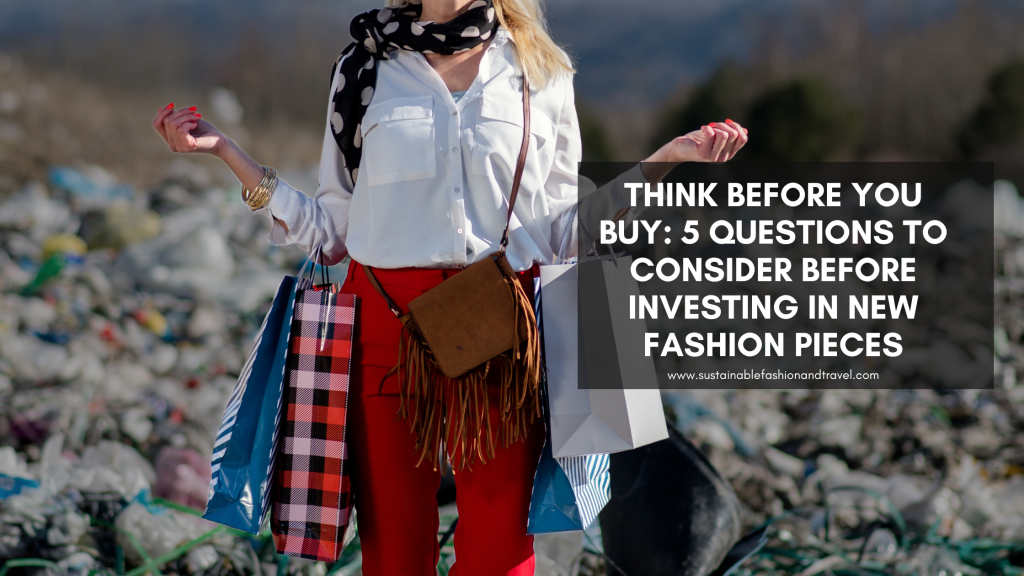In a world filled with fast fashion and fleeting trends, it’s important to pause and reflect on our consumption habits. As conscious consumers, we have the power to make a positive impact on the fashion industry and the environment. Before adding new pieces to my wardrobe, I find it crucial to ask myself a few essential questions. By taking a moment to consider our choices, we can embrace the principles of slow fashion. We are making more mindful and sustainable fashion investments. In this article, I will share the five important questions I ask consciously myself before making my next fashion purchase.
Does it align with your personal style and values?
Before buying a new fashion piece, ask yourself if it aligns with your personal style and values. Slow fashion encourages us to seek timeless, well-made garments that resonate with our authentic selves. Consider if the item reflects your individuality and can be effortlessly integrated into your existing wardrobe. Assess whether it aligns with your values, such as ethical production, fair trade, or sustainable sourcing. By supporting brands that share your values, you become an advocate for positive change in the fashion industry.
What is the quality and longevity of the item?
Investing in quality pieces has a profound impact on our fashion journey. I often go for garments that are crafted with care and attention to detail while considering the longevity of the item and whether it will withstand the test of my re-wearing it. Slow fashion encourages us to prioritize durable materials, timeless designs, and impeccable craftsmanship. By choosing quality over quantity, you reduce waste and build a sustainable wardrobe that will last for years to come.
Have you considered the environmental and social impact?
Before making a fashion purchase, take a moment to consider its environmental and social impact. Research the brand’s sustainability practices, such as their use of organic or recycled materials, their commitment to reducing waste, and their supply chain transparency. Depending on your location, look for certifications or initiatives that indicate their dedication to ethical production and fair labor practices. I personally look for certification when I’m in the Global North. This is because it’s equally crucial to recognize that small local businesses in regions like Kenya may face challenges in obtaining certifications due to limited resources and exposure to larger markets. In Kenya, many small local business owners may not have the financial means or the budget to pursue formal certifications. Despite this, it’s essential to acknowledge that ethical practices can still exist within these businesses. Their commitment to fair labor practices, sustainable sourcing, and community engagement may be evident through other means, such as word-of-mouth reputation, testimonials from satisfied customers, or engagement in local initiatives. Read more about this on “The Challenge of Eco Fashion Brand Certifications: An Insight into Small Brands in the Global South.”
By taking a comprehensive approach that acknowledges the challenges faced by small local businesses, we can build a more inclusive and sustainable fashion industry that values ethical practices regardless of formal certifications.
Do you really need it? Can you borrow, rent, or thrift instead?
In the spirit of mindful consumption, challenge myself to assess if I truly need the item I’m considering. I ask questions like Can I rent it for a short period or find a similar piece at a secondhand store? Embracing alternatives to buying new can significantly reduce your fashion footprint and promote the reuse and circulation of garments. Exploring these options not only saves money but also encourages a more sustainable approach to fashion.
How versatile is the item? Can you style it in multiple ways?
Versatility is key when building a sustainable wardrobe. Before purchasing an item, evaluate its potential for versatility. Consider if you can style it in various ways, pairing it with different pieces to create multiple outfits. Choosing versatile garments allows you to maximize their use, reducing the need for constantly buying new pieces. Embrace the joy and creativity of mixing and matching within your wardrobe to unlock countless possibilities.
By taking the time to reflect on these questions before investing in new fashion pieces, you become an active participant in the slow fashion movement. Make choices that resonate with your personal style, align with your values, and contribute to a more sustainable and conscious fashion industry. Remember, every purchase is an opportunity to support brands that prioritize ethical production, quality craftsmanship, and environmental consciousness. Together, let’s champion a more mindful approach to fashion and create a more sustainable future.
For more insightful articles on sustainable fashion and Eco Travel, visit sustainablefashionandtravel.com
#SlowFashion #ConsciousConsumerism #SustainableFashion #MindfulConsumption #FashionInvestments
